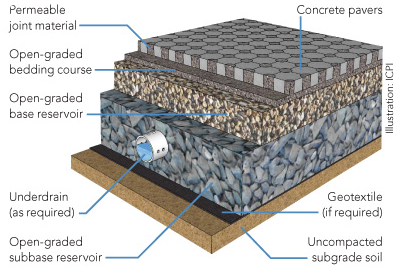Application: Aquifers, buildings, drainage systems, markets, reservoirs, roads and footpaths
Description: Permeable paving is a range of sustainable materials and techniques that allow the movement of stormwater through the surface of paving into the soil below. It may be constructed from pervious concrete, porous asphalt, permeable interlocking pavers, and several other materials. They function similarly to sand filters, filtering the water by forcing it to pass through different aggregate sizes and filter fabric. The spaces among the aggregates store water and enable infiltration into the soil subgrade rather than generating surface runoff. In addition, permeable paving surfaces trap and break down suspended solids, preventing pollutants from entering water and soil underlying the roadway, or to be carried to surface waters. They allow for water seepage to recharge groundwater while reducing peak flows and flooding.
Permeable pavers are carefully laid piece by piece after site preparation, which includes excavating the area and then installing a layer of gravel. A geotextile fabric is then laid over the surface, followed by a layer of sand. The paver units are then installed by hand or with special machinery. The holes or voids are filled with washed gravel, sand, pea gravel or soil.
Contribution to climate resilience: By reducing surface run-off, permeable pavers contribute to groundwater recharge and reduce flood flows. This increases the level of water in the aquifer for use in the dry season, increasing communities’ resilience to droughts that are likely to get worse with climate change.
Supplementary sources of information:
http://www.paversearch.com/permeable-pavers-menu.htm
https://www.epa.gov/soakuptherain/permeable-pavement
http://www.motherearthliving.com/gardening-tips/nuts-bolts.aspx
http://farleypavers.com/permeable-paver-installation/
Background image credit: https://blog.buildllc.com/2013/04/permeable-surfaces/
This resilience-building measure is sourced from the Water Resource Adaptation Guide (2019) published by the National Council for Sustainable Development at the Ministry of Environment in Cambodia. The full Guide is available to download at URL https://ncsd.moe.gov.kh/sites/default/files/2019-10/Water%20Resources%20Adaptation%20Guide_March%202019_En.pdf


